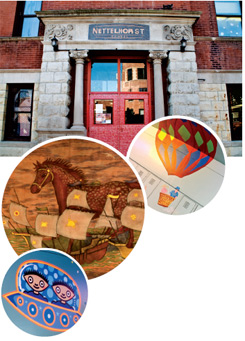Beyond the Quads
Roscoe Park 8 Takes Over
Alumna Jacqueline Edelberg leads the reform of a Lakeview school.
It took Jacqueline Edelberg, AB’89, PhD’96, only 15 minutes of Internet research to realize the school situation is Chicago is “really dire,” she says. She and husband Andrew Slobodien, AM’90, could just about afford to send their daughter to private school, “as long as we never ate out or went on vacation again.” As for Chicago Public Schools, the families she knew in East Lakeview all jockeyed to get their children into magnet schools—sometimes applying to 20 or more to get a single slot.
Then there was their neighborhood school, Nettelhorst Elementary, on Broadway one block north of Belmont. Built in 1892, the three-story red-brick school was among Chicago’s most prestigious elementaries until the 1950s. But by the late 1990s—when Edelberg first began trying to find a decent kindergarten for Maya and Zack, now ten and eight—it had become a dumping ground for unruly students bused in from overcrowded schools. In 1999 not a single child from the East Lakeview district, rich or poor, attended Nettelhorst.
Edelberg decided to visit anyway, taking along fellow parent Nicole Wagner. They found the school’s new principal, Susan Kurland, to be remarkably open and accommodating. After a three-hour tour, Kurland asked point-blank what she would have to do to get their kids to enroll.
The next day, Edelberg and Wagner returned with a 19-point list of demands: rigorous academics, low teacher-student ratio, recess (many CPS schools go without), healthy lunches, foreign language, parental involvement, a well-stocked library…and on and on. As Edelberg recalls, Kurland’s response was “Let’s get going, girls. It’s going to be a very busy year.”
Inspired, Edelberg mobilized seven neighborhood parents into the Roscoe Park Eight, named after a nearby playlot. Within a few weeks, the eight leaders had recruited 200 more families to join the Nettelhorst Parents’ Co-op. Its motto: “We do more during naptime than most people do all day.”
Edelberg and the Roscoe Park Eight set about transforming the school’s culture, beginning with its dour environment. They asked local stores to donate paint and local artists to create murals. Soon the school’s three floors were painted with earth, sky, and space motifs, and its wings for different regions of the world: India, Africa, Latin America. The lunchroom became a French bistro, complete with window boxes; the library got a reading bathtub.
The reformers scrounged for goods and services wherever they could find them; with Illinois ranking 49th in the nation for school funding, relying on the annual budget was not an option. Their first success was a $300,000 CPS grant to set up a “community school” within Nettelhorst in conjunction with Jane Addams Hull House. Nonprofits such as Lillstreet Art Center and Ballet d’Enfant agreed to offer classes for a fee after school and for free during the school day.
Through a registered nonprofit organization, Friends of Nettelhorst, the reformers then began to seek out corporate funding. Recent partners include the Chicago Blackhawks, who donated $200,000 to create a fitness center and floor hockey court. Takeda Pharmaceuticals gave money to renovate the outdated science labs, while Nate Berkus Associates plans to redesign the school’s teaching kitchen.
Six years later, test scores have tripled. Nettelhorst rarely accepts students from outside the district, and families move to East Lakeview just so their children can enroll. “I would put my kids’ education on par with any private education in the city,” says Edelberg. She calls the transformation of Nettelhorst “the most interesting political-science project of my entire life.”
Edelberg has taught at Chicago, Loyola, and DePaul, as well as Osnabruck University as a Fulbright scholar. The Nettelhorst project encompassed public policy, urban planning, political systems, even arts education, she says. “My training at the U of C”—where she took arts classes every quarter in addition to her political-science studies—“served me very well.”
In 2007, when it would seemingly take “an act of sabotage” to undo the reforms at Nettelhorst, Edelberg decided to write a book. How to Walk to School: Blueprint for a Neighborhood School Renaissance, co-written with Kurland, will be published next fall. The book includes a foreword by recently tapped Secretary of Education Arne Duncan, U-High’82, and afterword by Rahm Emanuel.
Edelberg hopes How to Walk to School will help shift the national discussion on public education, which has become snagged on vouchers and charter schools. “The neighborhood school model has served our country well for a hundred years. It worked because families and neighbors were invested in their school’s success,” she says. “There’s no need for a radically newfangled approach.”—Carrie Golus, AB'91, AM'93.

